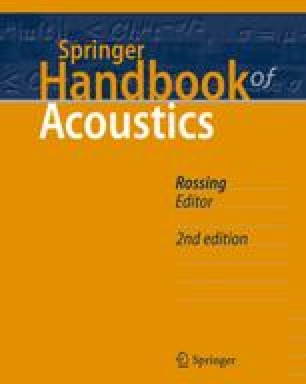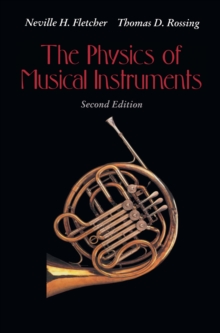Rossing Science Of Sound Pdf Download
A text for a one-semester, first or second year course on acoustics in general and musical acoustics in particular. After covering basic principles, Rossing (physics, Northern Illinois U.) explains more advanced topics such as the perception and measurement of sound, the human voice, and environment. The Science of Sound by Thomas D. Richard Moore; Paul A. Wheeler ISBN 13: 656 ISBN 10: Hardcover; Lebanon, Indiana, U.s.a.: Pearson. Logos Foundation - Stichting Logos. Where To Download The Science Of Sound 2002 Thomas D Rossing Paul A The Science Of Sound 2002 Thomas D Rossing Paul A Eventually, you will very discover a additional experience and endowment by spending more cash. Attain you admit that you require to get those all needs in the manner of having significantly cash?
PH106-N1 or N2 Science of Sound C 3, P 2, CR 4 Basic concepts of sound and human hearing are introduced. Topics include the history and development of basic acoustics and electricity, microphones, loudspeakers, signal processing, monitoring and recording systems, and an introduction to current digital audio.
PH 106 Science of Sound

I. CATALOG DESCRIPTION: PH106-N1 or N2 Science of Sound C 3, P 2, CR 4 Basic concepts of sound and human hearing are introduced. Topics include the history and development of basic acoustics and electricity, microphones, loudspeakers, signal processing, monitoring and recording systems, and an introduction to current digital audio. This course is not applicable as an electrical elective for Electrical majors. Pre-requisites: An appropriate math placement test result, MA090 Essential Math Skills, or MA091 Introductory Algebra. |
II. MATERIALS: Jul 13, 2020 CE44 for Windows is developed by Vertex Standard and is used by 5 users of Software Informer. The most popular versions of this product among our users are: 1.0 and 2.0. The names of program executable files are CE142CHN.exe, CE63Win.exe, CE64Win.exe, CE74Win.exe and CE77Win.exe. Vertex ce44 software download. The software & documentation provided here is the sole property of Vertex Standard LMR INC. USA and has been collected from various contributors. The software has been scanned and is virus/spyware free. All programming software has been compressed with WinRAR to decrease download times. The software must be downloaded and then uncompressed with. Wideband: USA. CE44 for Windows (VX-160. The most popular version of this product among our users is 2.0. Vertex VX-160 Programming Pkg for Windows - CE-44 (includes 9 pin serial port cable) (Note: You are buying the cable and we are GIVING you the software). YAESU, VERTEX, STANDARD Programming Software (Reference Chart). CE44 for WindowsVX-160180 Series is a software program developed by Vertex Standard. The primary executable is named CE44Win.exe. The setup package is about 1.03 MB (1,080,531 bytes) when donwloaded. Relative to the overall usage of users who have this installed on their PCs, most are running Windows XP and Windows 7 (SP1). Text (optional): The Science of Sound 3E, Rossing, Moore, & Wheeler, Addison-Wesley, ISBN 0-8053-8565-7 Free alternate Open Educational Resource (OER) texts: Sound, Physics and Music, Schmidt-Jones, via Open Stax. Acoustics via WikiBooks. The Acoustics text is at a traditional engineering level and is recommended for highly motivated students with a sufficient math background. Web: A nice on-line book is Sound: An Interactive eBook. Two professional sources are the Acoustical Society of America (http://acousticalsociety.org) and the Audio Engineering Society (http://www.aes.org). Other supporting materials and links may be found at the bottom of this page. Lab Manual (OER): Laboratory Manual for Science of Sound: PDFODTHTMLPRINT |
III. STUDENT LEARNING OUTCOMES: The student will demonstrate an understanding of the historical development of acoustics and audio, the methodology of its measurement, and its scope and relation to other disciplines. The student will demonstrate a basic knowledge of the fundamental nature of acoustics and human hearing, including an understanding of basic audio testing and audio electronics. The student will use algebraic and graphical techniques to solve basic problems involving acoustics and audio. The student will demonstrate skills in the application of audio test equipment and experimental techniques through the laboratory via individual and/or group exercises and demonstrations, to observe, measure, document, and evaluate acoustical and audio phenomena. The student will effectively gather experimental data via the laboratory exercises, analyze data using mathematical techniques explored in the lecture, and communicate their conclusions via presentations and/or written reports. The student will demonstrate the ability to work effectively as part of a team in the laboratory, to investigate, document, and analyze natural phenomena in the area of acoustics and audio. The student will demonstrate an understanding of the application of basic audio and acoustic principles in everyday life, including the areas of music, speech, and the variance of human hearing across populations. |
Syllabus
Background
Basic concepts of sound and human hearing are introduced. Topics include the history and development of basic acoustics and electricity, microphones, loudspeakers, signal processing, monitoring and recording systems, and an introduction to current digital audio. Success in this course requires a good working knowledge of algebra. Also, it is helpful if you have taken at least one lab course in high school or college. A basic $10 scientific calculator will be handy. Smart devices will not be allowed during tests. Some lab work will be performed using digital audio software. A portion of the lab exercises require a technical report due no later than one week after the exercise. Late penalty is one letter grade for the first half week, two letter grades for the second half week. Reports are not accepted beyond two weeks and receive a grade of 0. Remember, plagiarism is grounds for failure.
Week-by-week progress and assignments. Chapter readings refer to the Rossing text. Please note that we will not be covering every topic in the chapters listed.
Science Of Sound Wiki
| 1 | Introduction to course. History, development, relations to other disciplines. Explanation of scientific method. Theory vs. hypothesis vs. conjecture.We introduce systems of units and basic physical quantities and relations.
|
| 2 | This week we begin our study of vibrating systems and waves.
|
| 3 | We finish off the first section with resonance and look at musical instrument examples.
|
| 4 | We begin section two on the perception of sound.
|
| 5 | We continue with hearing and examine sound pressure and loudness.
|
| 6 | We look at acoustic spaces and consider topics such as reverberation time. Take a look at the photo links at the bottom of the page. Here is a nice on-line room mode calculator: http://www.hunecke.de/en/calculators/room-eigenmodes.html You might also wish to download this free graphical room mode calculator (Windows only): http://www.realtraps.com/modecalc.htm
|
| 7 | Around here we will have our first test. We wrap up the section on acoustic spaces.
|
| 8 | We start electroacoustics with a short introduction to basic electrical quantities (commonly associated with acoustical and audio measurements).We examine output transducers (e.g., loudspeakers). You may wish to download this free loudspeaker CAD software (Windows only): http://www.linearteam.dk/default.aspx?download=winisd
|
| 9 | This week we finish loudspeakers and look at input transducers such as micrphones.
|
| 10 | This week we begin discussion of signal processing. This is a wide-ranging topic and covers a lot of ground. We begin with the basics such as equalization, dynamic range compression, and limiting. We complete this with artificial ambience, namely reverb and echo
|
| 11 | We begin discussion of digital audio and discuss concepts such as quantization and quality versus storage/streaming bandwidth requirements.
|
| 12 | We continue with digital audio.
|
| 13 | We finish digital audio with MIDI and Internet audio including perceptual coding, MP3, and copyright issues. Time for our second test.
|
We finish the course with a discussion of the mathematics behind musical scale construction.
|
Resources
Notes and Problem Sets

Science, Waves and Sound Lecture Notes & Supplement.
Rossing Science Of Sound Pdf Download Windows 10

Labs
Laboratory Manual for Science of Sound: PDFODTHTMLPRINT
Imagery: Acoustics
Studio Double Wall
Studio Window
Studio Wall Ceiling
Studio Ceiling
Studio Floor
Studio Outlet
Studio Window Insert
Studio Sonex
Guitar Bass
I490 Wall
Sounds
200 Hz SinePic
200+600 SinesPic
200+600+1k SinesPic
200 Hz SquarePic
PianoSnare
PianoSnare 1 msec
PianoSnare 2 msec
PianoSnare 5 msec
PianoSnare 10 msec
PianoSnare 20 msec
PianoSnare 35 msec
PianoSnare 50 msec
PianoSnare 100 msec
Garage Clap
Garage Clap Minus 100ms
Studio Clap Single Sonex
Studio Clap Double Sonex
TimmyUmbwebweSegment CD Original
TimmyUmbwebweSegment 320 kbps
TimmyUmbwebweSegment 96 kbps
TimmyUmbwebweSegment 32 kbps
TimmyUmbwebweSegment 8 kbps
Roundabout Reverse
Fire On High Reverse
Strange Magic Snip
Expresso Snip
Pythagorean-ET 3rd
Pythagorean-ET 5th
Pythagorean-ET Major Chord
Rossing Science Of Sound Pdf Downloader
Links
On-line Room Mode CalculatorAlternate Equal Loudness DataOSHA Permisable Exposure Limit data and methods of estimation.
Rossing Science Of Sound Pdf Downloads
Suggested References:
Music, Physics, and Engineering 2E, H. F. Olson, Dover, ISBN 0-486-21769-8
Audio Engineer's Reference Book 2E, M. Talbot-Smith, Ed., Focal Press, ISBN 0-240-516850
Sound System Engineering 2E, D. & C. Davis, Sams, ISBN 0-672-21857-7
[Home][MVCC Home]
Science Of Sound Crossword
Rossing Science Of Sound Pdf Download Windows 7
